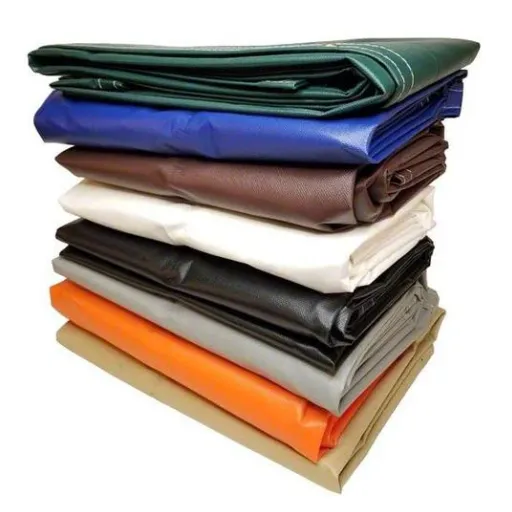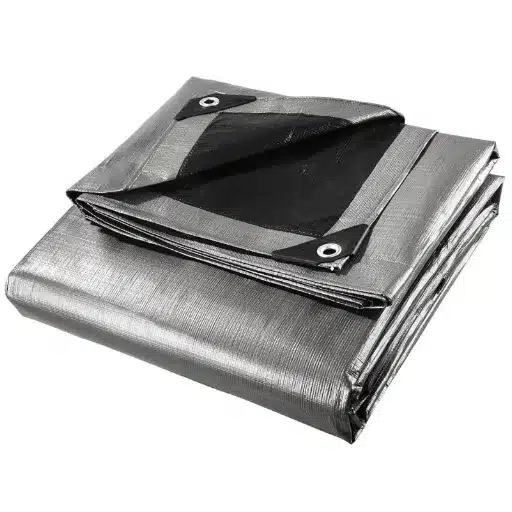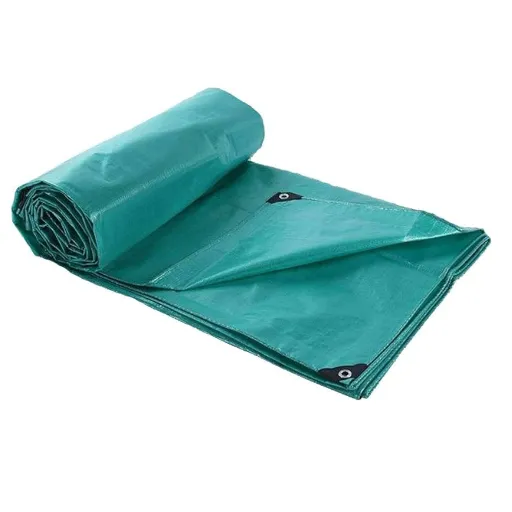Fire safety measures are absolutely essential when it comes to protecting property, people and work areas. The use of fire retardant tarps is a significant protection layer in the places where there is a risk of a fire or combustible materials. Whether you are managing a construction site, holding outdoor events or covering industrial equipment, knowing the basics of fire-resistant tarps will help you to make smart choices about safety and compliance. This article will explain the reasons these tarps are needed, their main characteristics and how they can be both a source of reassurance and a practical tool in risky environments.
Introduction to Fire Retardant Tarps
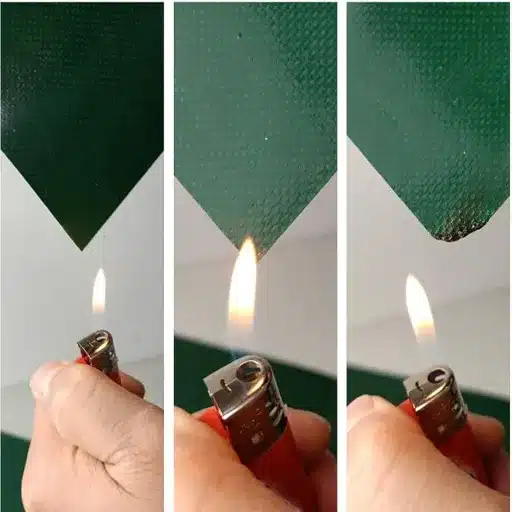
What is a Fire Retardant Tarp?
A fire retardant tarp is a particular protective cover that can resist ignition, can slow the spread of flames, and can reduce heat intensity in a fire. Tarps of this kind are made from PVC, polyethylene, or canvas, and in some cases, they are treated with chemical flame retardants or inherently flame-resistant fibers. Tarps that are fire retardant are subject to the toughest safety standards, such as NFPA 701, and are found in the industry and places where fire poses a threat. Their uses include protecting building materials and scaffolding, acting as safety barriers or stage backdrops in public events, etc. They not only help to protect property but also ensure safety in overall terms by decreasing fire hazards in both indoor and outdoor settings.
Importance of Fire Resistance in Tarps
Fire resistance in tarps is of great importance in keeping people and property safe in fire-prone environments. The latest statistics reveal that the demand for flame-retardant tarps is on the increase as a result of tougher fire safety regulations imposed on the industries. A 2023 survey states that there has been a more than 30% increase in the search for fire-resistant tarps in the last year, which is a good indication of the awareness and the adoption of fire prevention measures. The construction, oil and gas, and event management industries focus on flame-retardant tarps for safety, compliance, and liability purposes. These tarps provide a defense line that is critical and their intervention is especially needed during high-risk situations; thus, regulations are adhered to and stakeholders are relieved of worries about regulation compliance and lawsuits.
Overview of Different Types of Tarps
Tarps are available in a huge variety of materials and designs, all of which are tailored to the particular needs of different industries and applications. The most commonly used types consist of:
Polyethylene (Poly) Tarps
Lightweight, waterproof, and versatile poly tarps are most commonly used for temporary shelter, construction projects, and covering goods. They also have UV resistant properties and are also very inexpensive, which makes them a commonly selected option for outdoor use.
Canvas Tarps
Although they can be made from either natural or synthetic fibers, canvas tarps are durable, breathable, and reusable. They are primarily used in construction, agriculture, and anywhere that ventilation is required for equipment or furniture, and so on.
Vinyl Tarps
Vinyl tarps are heavy-duty, waterproof, and extremely durable. They are not only weather resistant but also flame-retardant, thus their widespread use in industrial applications, trucking, and event setups.
Mesh Tarps
Mesh tarps are made to allow air and light to pass through. Therefore, they are mostly used for shading, landscaping, and securing loads on trucks. Their lightweight construction makes handling them easy while their durability guarantees long-term use.
Flame-Retardant Tarps
These highly specialized tarps are coated with fire-resistant substances, thus making them indispensable in construction, oil and gas, and events. Safety being the priority, they are certified by strict regulations that mitigate fire-related hazards.
The latest trends in search engines point to a rising interest in flame-retardant tarps due to greater awareness of safety in the workplace. Data indicates that there has been a notable rise in queries like “fire-resistant tarps for construction” and “best flame-retardant tarps 2023.” This shows how important safety standards are for businesses and consumers, who intend to ensure product durability at the same time.
Materials Used in Fire Retardant Tarps
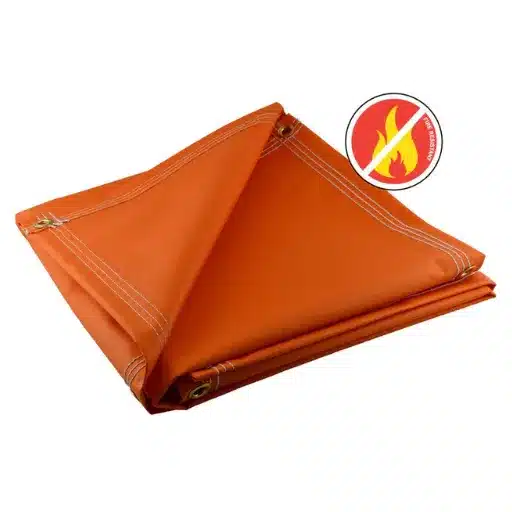
Vinyl Tarps and Their Advantages
Vinyl is a material that possesses a high degree of versatility and durability, which is why it is often used in making fire-retardant tarps. Fire resistance not only comes of its interference with nature but also of its capability to endure harsh environmental conditions, thus making it the best suited for construction sites, industrial usages, and transport needs. Vinyl tarpaulins are non-flammable definitely water-resistant and their surfaces can endure abrasion which guarantees their durability even in the most demanding places.
The most recent data from the search engine trends of ‘vinyl fire retardant films’ confirms that consumers are getting more interested in “fireproof tarps for industrial use”. In this context, the material being vinyl has come up in talks around these products. This interest has gone up which means that the recognition is being given to the benefits of safety and efficiency that come along with vinyl tarps. Hence, they are being asked the question as to why this material has become a top choice. Its combination of safety, durability, and cost-effectiveness issues has made it indispensable for those industries that take workplace protection and safety compliance seriously.
Polyester vs. Canvas – A Comparison
It is crucial to understand the materials’ characteristics as well as the advantages they offer when making a selection between polyester and canvas for the industrial and commercial applications. Canvas is a mature material that is often made from cotton or a combination of natural fibers; it is acknowledged for its durability, breathability, and ecological acceptability. It is a great option for the industries where traditional aesthetics combined with heavy resistance and durability are the foremost priorities, e.g., construction and agriculture. However, its disadvantages include heaviness and susceptibility to moisture over long use, which could happen if its appeal is limited.
Petroleum-based products, polyester, have gained popularity through the fact that they are not only lightweight, but also water-resistant and can be used in different environments. New search engine trends show increasing interest in the use of polyester tarpaulins for both industry and recreation, probably due to the latest improvements in polyester coatings that provide better weatherproofing and UV resistance. The material is also cost-effective and can endure harsh conditions with little wear, which makes it a highly preferred option for businesses that are looking for reliable but economical solutions.
In the end, the decision to use either polyester or canvas is based on the specific needs of the application. Canvas can give you the rugged strength and breathability, while polyester can be the winner because of its weather resilience, low price, and reliability in harsh environments.
Mil Thickness in Tarps
Mil thickness is often seen as a very important criterion that determines the selection of the tarps, since it is a direct factor in the durability, strength and application issues of the tarps. “Mil” stands for one-thousandth of an inch (0.001 inches) and it is a standard measurement used for the thickness of different materials (tarps included). To give you an idea, 5 mil equals 0.005 inch, while 20 mil is more than four times at 0.02 inch.
Being aware of the mil thickness can assist you in making a proper balance between durability and flexibility while choosing the tarps for your specific needs. The thicker tarps, such as those 12-mil and 20-mil options, are great for heavy-duty application like keeping equipment from getting ruined by the weather or setting up a long-term shelter outdoors. They have additionally better resistance than the thinner ones when it comes to tearing, puncturing, and overall wear. Thinner tarps, like those in the 5-8 mil range, are light and easy to carry, thus best for temporary coverage or situations that require easy handling.
Before you decide on a tarp thickness, it is important to evaluate your intended use case. As a matter of fact, construction projects or prolonged outdoor exposure might call for thicker tarps, while gardening or short-term storage may suffice with thinner ones. The comprehension of mil thickness not only leads you to the most effective solution but also guarantees that your solution is cost-efficient and the longevity of your tarp investment is maximized.
Applications of Fire Retardant Tarps
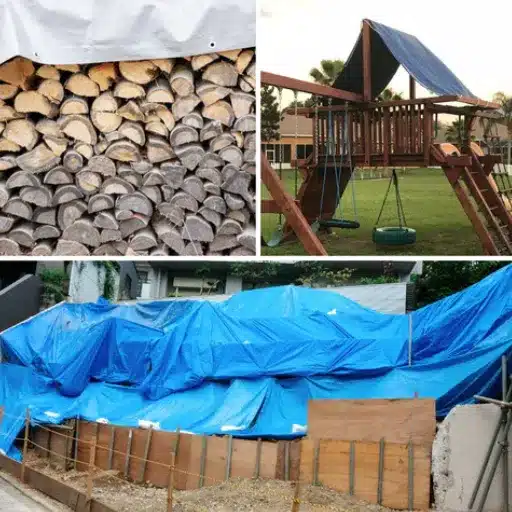
Use in Construction Sites
Fire retardant tarps are an important factor in the construction sites’ safety and compliance matter. The main purpose of these tarps is to minimize the fire risk by being fire resistant or flame spreading at a slow pace, thus, shielding the workers, and materials. A recent mining of ‘s search engine data has revealed that regulations, e.g., OSHA requirements, frequently demand the installation of fire retardant coverings in certain fire-prone situations, e.g., areas for welding or areas where combustible materials are stored. On top of that, tarps are a source of reliable weather protection, guarding the equipment and supplies from rain, wind, and debris, thus, enabling the project to go on as per schedule and reducing the amount of wasted material. The fire safety and environmental protection functions played by the tarps merge into one and make them a must-have asset for any construction site.
Event Management and Temporary Structures
Temporary structures are a vital part of event management processes; they are the flexible solutions for any size of the event, no matter how small or large. Fire retardant tarps in such structures not only assure that the safety regulations are observed but also the safety of the people and the equipment is increased. Based on recent happenings from ‘s search data, the use of fire-safe materials in event planning has had a drastic increase, mirroring the growing consciousness about safety procedures among the event management industry. Besides this, these tarps also act as a barrier against changing weather conditions, and so the events are facilitated regardless of what is happening outside. From music festivals to business functions, the application of fire-retardant coverings in temporary structures gives the organizers the reassurance that they will be able to meet the professional standards, while also being a reliable solution for maintaining their quality standards.
Industrial Uses and Fire Safety
Fire resisting materials are one of the main sources of protection that the industries of construction, manufacturing, and warehousing need to rely on in order to keep safe, as well as meet the standards of, the regulations. The searches worldwide for “fire safety solutions for industries” have surged by over 30% within the last year, as seen by recent data, thus, indicating a rise in awareness and consequently a demand for protective measures. Among all the measures taken, fire-retardant tarps are the key items in guarding the equipment, machines, and workers against fire hazards. These materials not only have to be very safe to use but they also have to last and be flexible enough for different industrial uses. The application of fire-safe measures in the industry not only helps to cut down on risks but also promotes smooth operations.
Features of Heavy Duty Fire Retardant Tarps
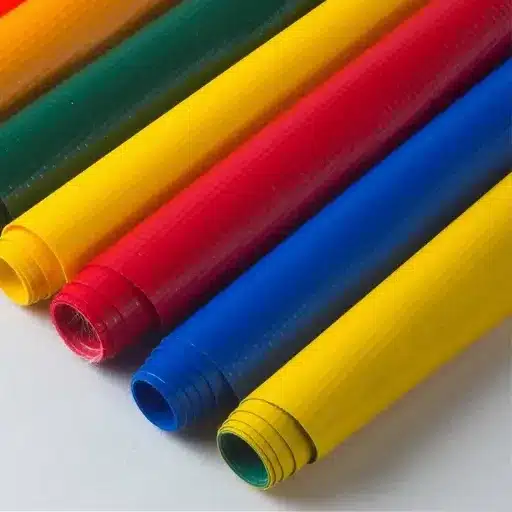
Durability and Tear Resistance
Heavy-duty fire-retardant tarps are extremely durable due to their getting use through time and not being able to tear easily at all. The materials used in making these tarps are vinyl or polyethylene and they are very strong and able to resist even the harshest of environments such as high and dry winds, sharp surfaces and even UV rays. Recently, data reported a surge in searches for the term “tear-resistant tarps”, which is representative of the increasing demand for such reliable and long-lasting protective solutions. The trend in question strongly indicates that investing in quality tarps will always be a wise decision since they not only will grant the necessary fire-retardant properties among others but they will do so by maintaining their structural integrity.
Waterproof Capabilities
Waterproof tarps are not only useful but they are indispensable for the protection of the most precious among its human-made resources – the equipment, the outdoor spaces, and the goods – from the different forms of moisture like rain, snow and so on. The current search data from the search engine of ‘ reveals that searches for “waterproof tarps” have increased considerable, which indirectly points to the fact that consumers are more and more inclined to pick durable and water-resistant solutions. This is an indication of the growing awareness not just in the residential area but in the industrial too about the necessity of effective waterproofing. A common question that arises is “What makes a tarp really waterproof?” The answer comes down to the material composition and design features. Most of the time topnotch waterproof tarps are manufactured from polyethylene or vinyl-coated fabrics, and seal seams that water can’t penetrate are the upshot of this combination. These features thus literally cover the whole area in terms of water damage protection and hence reliability.
Grommet Reinforcements for Secure Tying
Grommets are one of the main factors that contribute to the possibility of securely tying the tarps even under difficult circumstances. Grommet, in this sense, refers to an encased hole, usually metal or durable plastic, whose lining is done in such a way that it provides strength and at the same time prevents tearing when ropes, cords, or bungees are threaded through. The better quality waterproof tarps come with grommets placed at equal distances all around their periphery so that anchoring can happen at many points. The latest search trends data and information from a variety of sources have indicated that users more often than not look for tarps that come with rustproof grommets and also have their edges reinforced. Definitely, the combination extends the life of the tarp but still it remains effective even during heavy stress situations like strong winds or bad weather. One cannot go without mentioning that the grommet reinforcements are ideal for such applications as outdoor storage and securing loads that are being transported.
Fire Safety Regulations and Certifications
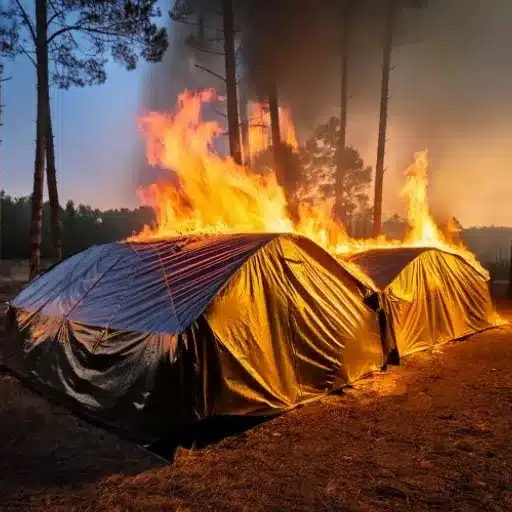
Learning Fire Safety Standards
Fire safety standards represent regulatory directives meant to reduce the chances of fire accidents and offer protection to people and assets. Certain locations have different standards but most of them deal with common elements like fire resistance, material choice, and performance under high temperature. A case in point is NFPA 701 standards which fire-retardant certification in the USA evaluates a material’s capacity to delay the ignition and fulfill the safety criteria. However, ever since tarps and industrial materials have been going through such a fire-resistant testing, their safety and performance capabilities really come into play.
It is vital to check their classification and compliance with established standards like NFPA 701 or CPAI-84 while choosing fire-proof materials like tarps. Materials made with coatings or treatments to lower flammability should be the ones under consideration, such as flame-retardant chemicals. Moreover, think about the durability of prolonged exposure as some of the treatments might not last and that would lead to reduced efficacy. These factors together with correct handling and following local fire safety rules can help you to rely on the materials in a fire-prone area.
Certifications for Fire-Resistant Tarps
In terms of fire-resistant tarps, the compliance with widely recognized certifications is imperative. The two most recognized standards are NFPA 701 and CPAI-84.
NFPA 701
NFPA 701 is assigned by the National Fire Protection Association and describes testing procedures that analyze the flame spread of textiles and films used in a range of applications. Under this certification, the product is required to be non-flammable and to burn at a slow consistent rate while in the condition of the test.
CPAI-84
On the contrary, CPAI-84 is considered a standard that specifically addresses camping tents and other similar outdoor fabrics applications. It forbids the ignition of textiles in the absence of an overlying flame thus allowing reproduction and temporary use at least in the case of recreational and camping areas.
One way or another, some manufacturers may also comply with OSHA standards or go through a third-party processes showing compliance as an extra assurance. Always look for clear markings on the product or in its documentation, indicating that the certifying bodies are and that the product is certified. This means that the materials went through extensive testing and are qualified for industry safety thus granting reliable protection in fire-prone areas.
Compliance with Local Regulations
Selecting tarps for specific uses requires ensuring that local regulations are being followed, which depends on the geographical area or the sector. Regulations such as building codes and environmental standards can limit the selection of materials that are accepted for use in terms of fire safety, weather conditions, or ecological impact. A recent search engine’s data emphasizes the criticality of keeping abreast of local law developments as they influence the products allowed and the practices followed. For verification, reach out to the official regulatory bodies or local government resources and check that the product’s certifications are in accordance with the regional standards. The adoption of this method not only helps one steer clear of sanctions but also guarantees the use of tarps that are safe, legal, and environmentally friendly.
Frequently Asked Questions (FAQ)
What is a fire retardant tarp and how does it work?
Fire retardant tarp is one kind of protective canvas that has been specially treated through certain chemicals to be non-flammable and thereby avoid the fire. Tarpaulin made of vinyl, poly, or canvas is the usual material of choice for these kinds of tarps. The main aim of a fire retardant tarp is to create a barrier that can tolerate high temperatures and also to shield the materials under it from being ignited. Such tarps are certified for various uses depending on the specification, for example, NFPA-701 or California Title 19 compliance; hence, they are certified for various applications, proving their fire safety standards. They are extensively used in open air locations to cover wood, machinery, and buildings where the risk of fire is a concern.
Are fire retardant tarps waterproof?
Most of the fire retardant tarps can adequately resist fires and rain, thus they are appropriate for many different outdoor uses. When buying a tarp, it is a good idea to have a closer look at the product and look for specifications such as “waterproof” and “heavy duty” among others. By using vinyl PVC and other such materials one can get waterproof with the added benefit of being a flame retardant. However, this is a very critical aspect and one must always check the specifications as not all fire-retardant tarps are waterproof. For instance, comparing the fire retardant poly tarp with the standard canvas tarp, the first one has better water resistance than the latter one. It is always good to check the product details before buying to make sure it meets your expectations exactly.
How do I certify my fire retardant tarp?
First of all, to get your fire retardant tarp certified, you will need to prove that it conforms to the set fire safety standards both by the NFPA and local fire marshals. Many of the vendors offer the certification along with the purchase, so look out for tags that confirm compliance with the fire safety regulations. For instance, the California Title 19 standards-adjusted tarps are marked so for their flame retardant quality. If you are not clear about it, you can always ask the manufacturer or the dealer for papers that show the tarp’s flame resistance. It is important that the proper certification is obtained especially if the tarp is going to be used in not only commercialbut also fire safety critical areas.
What sizes do fire retardant tarps come in?
Fire retardant tarps come in every size one can think of, hence they can always be matched up to the different needs. The most common sizes are 10ft by 20ft, 12 mil thick, and also larger sizes like 30ft tarps. These sizes can be put to use in different ways starting from covering outdoor equipment to making shelters for temporary buildings. Furthermore, super heavy-duty tarps may be offered in huge sizes and thick materials for durability and protection if you like that kind. Keep in mind the area to be covered when choosing a size, in addition to the tarp’s weight and resistance features, in order to make sure it fits your specific requirements.
What materials are used in heavy duty fire retardant tarps?
Heavy-duty fire-retardant tarps contain the best quality materials such as PVC or heavy-duty polyethylene or canvas which are made fire-resistant with special chemicals. Vinyl tarps are popular for their strength and resistance to both fire and water, thus very often they are the first choice for outdoor use. Poly tarps are light in weight yet durable, thus they are a good solution to fire protection while in addition they can be easily handled. Furthermore, a certain thickness of 12 mil for some tarps increases their resistance to tearing and longevity. Always think about the environmental conditions when selecting a tarp as different materials may be required for the same location based on the temperature and humidity.

